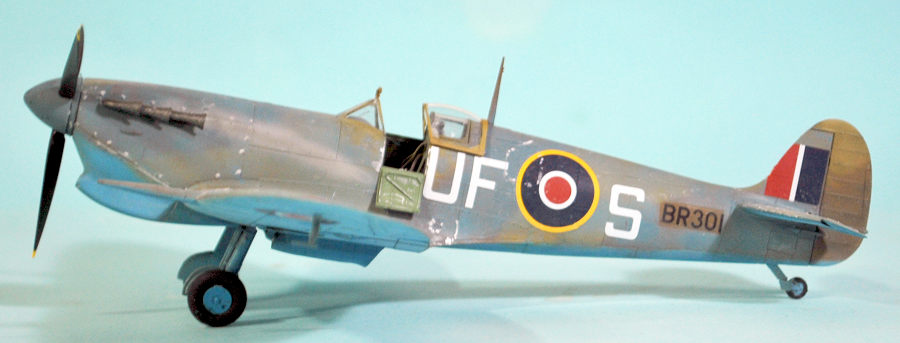
Eduard 1/48 Spitfire Vc
| KIT #: | 82185X |
| PRICE: | $22.95 |
| DECALS: | None |
| REVIEWER: | Tom Cleaver |
| NOTES: | Overtree |

| HISTORY |
The Spitfire Vc was developed from experience with the Spitfire Vb and began to appear in 1942. Unlike the earlier version, which was essentially a Spitfire I airframe “beefed up” around the engine mounts to allow use of a Merlin 45 engine, the Spitfire Vc embodied more changes. These included a re-stressed and strengthened fuselage structure with the new windscreen design which featured the armor glass integral with the rest of the structure; this was also used on some late-production Spitfire Vb’s. The Vc also introduced the Type C or "Universal" wing along with the revised main undercarriage; the tops of these wings featured large, bulged fairings to provide clearance for the ammunition feed motors of two Hispano cannon. Because two cannon were seldom fitted, these fairings were later reduced in size to more streamlined shapes. A deeper radiator fairing was fitted under the starboard wing and a larger oil cooler with a deeper, kinked air outlet was fitted underneath the port wing. In addition more armor was added, protecting the bottom of the pilot's seat and the wing ammunition boxes.
George Frederick "Buzz" Beurling was the most successful Canadian fighter pilot and flying ace of the Second World War. Known as "Canada's most famous hero of the Second World War", as "The Falcon of Malta" and the "Knight of Malta", he was credited with shooting down 27 Axis aircraft in just 14 days over the besieged Mediterranean island. Beurling's wartime service was terminated prior to war's end, for repeated stunting and his lack of teamwork.
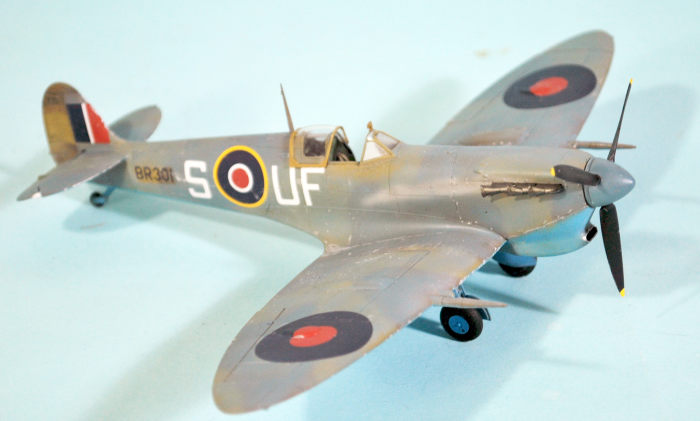 With the outbreak of war, he tried to join the Royal Canadian
Air Force, but his lack of academic qualifications led to his rejection.
He then tried to join the Finnish Air Force but could not get his
parents' permission. Instead, he went across the Atlantic on a convoy
intending to enlist in the Royal Air Force. Unfortunately, he had
forgotten his birth certificate and had to return to Canada. In
September 1940,[after survivng a second trip, the RAF accepted him as a
pilot.
With the outbreak of war, he tried to join the Royal Canadian
Air Force, but his lack of academic qualifications led to his rejection.
He then tried to join the Finnish Air Force but could not get his
parents' permission. Instead, he went across the Atlantic on a convoy
intending to enlist in the Royal Air Force. Unfortunately, he had
forgotten his birth certificate and had to return to Canada. In
September 1940,[after survivng a second trip, the RAF accepted him as a
pilot.
Beurling reached No. 7 Operational Training Unit, at RAF Hawarden, in September 1941, where he came under the influence Ginger Lacey, who said of him, "There are not two ways about it, he was a wonderful pilot and an even better shot."
Beurling landed on Malta on June 9, 1942, assigned to 249 Squadron after taking off from HMS Eagle during Operation Salient and had his baptism of fire on June 12 when he and three other 249 pilots intercepted eight Bf 109s. He claimed to have blown the tail off a Bf 109, but nobody saw it; he was credited with a "damaged". After that, he claimed a series of victories that had no equal on Malta. On July 6, with other pilots , he attacked a formation of three Cant Z1007bis, 14 Reggiane Re.2001s and more than two dozen Macchi C.202s. He shot down Sergente Francesco Pecchiari from 352nd Squadriglia. Then he claimed another Macchi flown by Sottotenente Romano Pagliani,152th Squadriglia. During this fight, the Italians claimed two Spitfires, one by Furio Niclot Doglio, who Beurling would kill three weeks later. The RAF suffered no losses, but Beurling's aircraft was badly shot up. However he made a third claim that day, a Bf-109 hit from a distance of 800 yards.
On July 10, Beurling scored a fifth victory when he shot down the C.202 of Sergente Maggiore Francesco Visentini, from 378th Squadriglia.
On July 12, while searching for Pilot Officer Berkeley-Hill, who was missing, he spotted Tenente Colonnello Aldo Quarantotti and Tenente Carlo Seganti, flying Re.20012, who were looking for Tenente Francesco Vichi. Beurling, with withman Flying Officer Erik Hetherington, dived on Seganti and shot him down, the closed to 100 feet and just when Quarantotti spotted him, he fired a short burst that decapitated the Italian commander. On July 14, he was shot up by two Re. 2001s during which "An explosive bullet nicked my right heel", he recalled.
On July 22, he lost his best friend on Malta, French-Canadian Pilot Jean Paradis. The following day, eight 249 Spitfires were scrambled. Beurling claimed to have badly damaged a bomber and, after a long dogfight with a Reggiane, to have shot down Sergente Maggiore Bruno Di Pauli’s C.202.
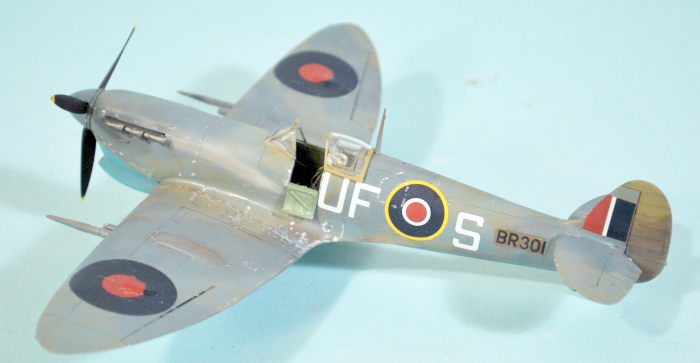 July 27 was Beurling's
"biggest day on Malta." He shot down Sergente
Faliero Gelli,and immediately afterwards, Capitaine
Furio Niclot Doglio, the top Italian ace, both flying C. 202s. In a
later mission, he claimed two Bf 109s, one flown by
Leutnant Karl-Heinz Preu of JG 53. On July 30 he
was promoted from Sergeant Pilot to Pilot Officer after being awarded
the DFM.
July 27 was Beurling's
"biggest day on Malta." He shot down Sergente
Faliero Gelli,and immediately afterwards, Capitaine
Furio Niclot Doglio, the top Italian ace, both flying C. 202s. In a
later mission, he claimed two Bf 109s, one flown by
Leutnant Karl-Heinz Preu of JG 53. On July 30 he
was promoted from Sergeant Pilot to Pilot Officer after being awarded
the DFM.
Beurling was bedridden for much of August and September, due to poor diet and dysentery. On August 8, while chasing a Bf 109, he was jumped by two more; hi shot down one but was shot down either by Herbert Rollwage or Siegfried Freytag of I/JG 77. On September 25, he claimed three Bf-109s but two returned to their base on Sicilyt, while the third was flown by Kurt Gorbing, who made a forced-landing and died shortly afterwards.
On October 10, whuile air-testing his newly serviced Spitfire when he was vectored to intercept two Bf 109s which brought his score to 21, though there is no record of a German loss. On October 13, he attacked a formation of Ju 88s escorted by 30 Bf-109s. He claimed to have hit a bomber, then a Bf-109 that burst into flames, then a second who pilot bailed out. On October 16 he was awarded the DFC.
Buerling dedicated himself to the art of aerial combat and angered his commanders with his disdain for teamwork. He had a marked skill at deflection shooting and "situational awareness." He owed his success to remarkably good eyesight and the ability to "toss his Spitfire" into violent combat maneuvers. If jumped from behind, he would pull back on the control stick of his Spitfire so hard the aircraft would enter a violent stall, flick over and spin. This was a hard act for the enemy on his tail to follow. Beurling would also ram his controls into a sudden violent turn that caused his Spitfire to flip over and drop like a stone.
Beurling was shot down four times over Malta. In his last, he was probably shot down on October 14 by Oberfeldwebel Riker of 4/JG53 or Leutnant Karl von Lieres of 2/JG27. Of the seven Ju-88s claimed to have been shot down by the RAF, only one did not return.
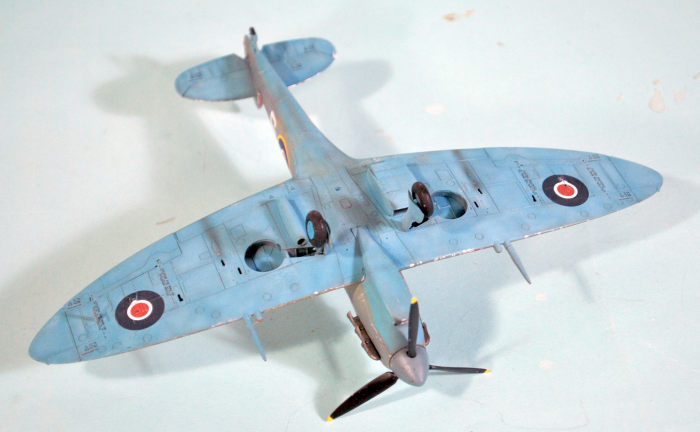 Beurling was sent back to Britain on October 31, 1942. The B-24
he was aboard crashed into the sea off Gibraltar and he was one of only
three survivors.
Beurling was sent back to Britain on October 31, 1942. The B-24
he was aboard crashed into the sea off Gibraltar and he was one of only
three survivors.
Back in England, he transferred to the RCAF and was posted to 403 Squadron, flying the new Spitfire IX. After shooting down an Fw-190 of JG 2 in September 1943, he requested command of a flight of Mustangs to carry out deep penetration raids into Germany. His request was turned down. Beurling was promoted to Flight Lieutenant, but his stunting of a Tiger Moth at zero feet over his airfield led to Wing Commander Hugh Godefroy threatening him with a court martial. He was sent to 126 Wing HQ and then to 412 Squadron.
Beurling returned to Canada in April 1944. He was given an honorable discharge in October. He was turned down when he tried to join the USAAF. Recruited to join the then-clandestine Israeli Air Force, he fatally crashed a Noorduyn Norseman landing at the Rome airport on May 20, 1948, six days after the Israeli Declaration of Independence
| THE KIT |
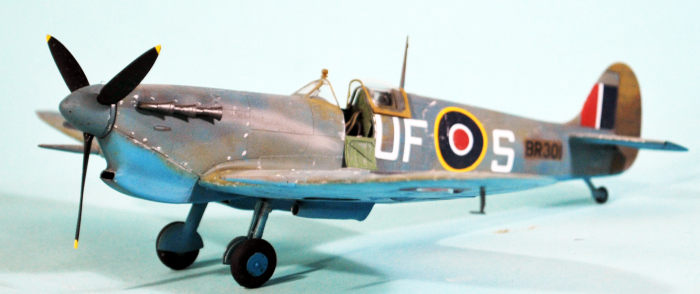 This is the first kit of the Spitfire Vc in 1/48 by a mainstream
company, following the release of a Spitfire Vc in 1/72 by Airfix last year.
Special Hobby has released a Sptifre Vc several years ago, which has
dimensional problems (noticeably too short in the rear fuselage) and Sword
released a Spitfire Vc in 1/72. Airfix released a 1/72 Spitfire Vc last
year.
This is the first kit of the Spitfire Vc in 1/48 by a mainstream
company, following the release of a Spitfire Vc in 1/72 by Airfix last year.
Special Hobby has released a Sptifre Vc several years ago, which has
dimensional problems (noticeably too short in the rear fuselage) and Sword
released a Spitfire Vc in 1/72. Airfix released a 1/72 Spitfire Vc last
year.
This kit lives up to all the other Spitfires released so far by Eduard. The wing features separate cannon covers, with the classic large teardrop fairing, a squarish teardrop fairing and the later narrow fairing, to fully cater to the “C” wing. A second pair of cannon are also included, for Malta based Spitfires and for the Spitfire Vc fighter-bombers operated by 2 Squadron SAAF in Italy. A special sprue “T” has the Vokes filter and two different “Aboukir” filters, as well as the deeper radiator and oil cooler for the Spitfire Vc.
| CONSTRUCTION |
Construction of this kit is no different from the other Eduard releases.
With ALL the Eduard Spitfire kits, you MUST insure that EVERY SPRUE NUB IS REMOVED. The mating surfaces must be ABSOLUTELY CLEAN. Take your time fitting parts together and be sure they are EXACTLY where they should be before committing any glue. Get the fuselage together nice and tight with that cockpit assembled and positioned perfectly.
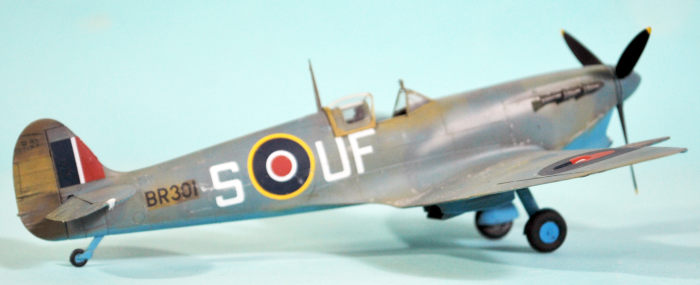 To avoid some “industrial strength pushing and shoving” to get the
wing and fuselage sub assemblies together, do not assemble the wing prior to
attaching the lower part (with the gear wells) to the fuselage. Then attach
the upper wings, which is now easy and you will have perfect fit with no
filler needed anywhere. All else just goes together.
To avoid some “industrial strength pushing and shoving” to get the
wing and fuselage sub assemblies together, do not assemble the wing prior to
attaching the lower part (with the gear wells) to the fuselage. Then attach
the upper wings, which is now easy and you will have perfect fit with no
filler needed anywhere. All else just goes together.
The airplanes arrived on Malta carrying four 20mm cannon as a way of getting spares there. Many - not all but apparently most - of the Vc's had the inner cannons removed, as well as the four .303 machine guns to save weight. So the wing looks like an "e" wing. I also used the "square" cannon cover rather than the teardrop, mostly just because that makes for visual difference with other "C" wing Spitfires, but it also might have been done with 4-cannon Spitfire C wing airplanes.
I used an Eduard photoetch seatbelt and Eduard decals for the instrument panel.
| COLORS & MARKINGS |
I chose to do Spitfive Vc BR 301, which may be the top-scoring Malta Spitfire, flown by several aces in the summer in 1942, including George Buerling for the majority of his 15 victories in July 1942.
BR301 was one of the Spitfire Vc's brought by USS Wasp on her second Malta resupply mission in early May, 1943. As such, it is generally suspected she is one of the "Blue Spitfires." As with all the others, exactly how that was done, (since the RAF at Malta completely failed in their duty to record everything for posterity - and modelers - due to their completely selfish concern with fighting a daily war for survival) - is at best an “edumacated guess.”
Research done by Ron Lowry that was published in Robert Bracken's great "Spitfire: the Canadians" has BR301 in an overall blue scheme of Azure Blue lowers, and a light and dark blue uppers, painted over the desert scheme of Dark Earth and Middle Stone, with the rudder unpainted and the serial having been masked off, which reveals the desert scheme background. This repaint may have been done aboard Wasp, using paint available on the ship.
 Nobody really knows if that is right, any more than they can be sure
of any of the other Blue Spitfires. I think Lowry is 80% right. But I then
bring my own first-hand knowledge of how the US Navy does "quick and dirty."
Nobody really knows if that is right, any more than they can be sure
of any of the other Blue Spitfires. I think Lowry is 80% right. But I then
bring my own first-hand knowledge of how the US Navy does "quick and dirty."
I agree that the Blue Spitfires were likely done aboard Wasp. They had a week from taking the airplanes aboard in the UK to getting to the launch position in the Mediterranean, which gives the time to do so that would not have been available on Malta in the midst of a daily fight for survival. What I think might have been done is that the Navy Medium Blue paint available for maintenance of the carrier's air group was not a huge supply, so it would have been "stretched" - thinned - and probably thin enough that it barely covered the color scheme beneath, and it was done quickly by people with paint brushes. No neat spray jobs. Thus, the "dark" and "light" blue upper scheme is the thinned blue paint over the Dark Earth and Middle Stone. As I found doing this myself, there is a need for a second coat over the Dark Earth, which would by why the airplanes were said to have a “two tone blue” camouflage.
Is this definitively right? Unknown. But it fits the operational situation and conditions under which the work would have been done.
The individual ID letters and serial, and the national insignia, caem from from "Spitfire: Aces of the Empire" for BR301. I used the kit stencils, which can be partially seen through the thinned blue overpaint.
The kit doesn’t supply an accurate DeHavilland wider-blade prop, and the narrow-blade Rotol wasn’t actually used on Spitfire Vs. However, a few minutes with a sanding stick turned that prop into something that looks “close enough” to the DeHavilland prop. The spinner was painted white, then masked off for the stripe, and the rest painted X-3 Royal Blue. I “muddied” the wheels as shown in photos. I unmasked the canopy and posed it open.
| CONCLUSIONS |
It’s an Eduard Spitfire. And a Spitfire Vc! What’s not to like? Not a kit for a beginner, but anyone with some experience can tackle it successfully. Take your time, be sure the parts are clean, be precise in fitting things together, and you will have a model you’ll be proud to display. Highly Recommended for all Spitaholics.
Tom
Cleaver 10
February 2022 Copyright ModelingMadness.com. All rights reserved. No
reproduction in part or in whole without express permission. Review kit courtesy of my billfold.
If you would like your product reviewed fairly and fairly quickly, please contact the editor or see other details in the Note to Contributors.